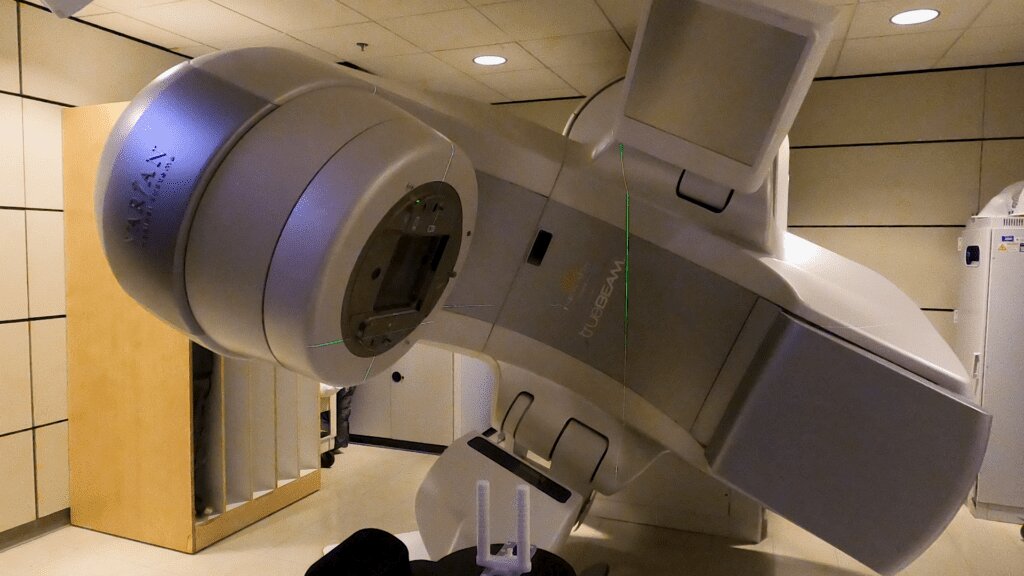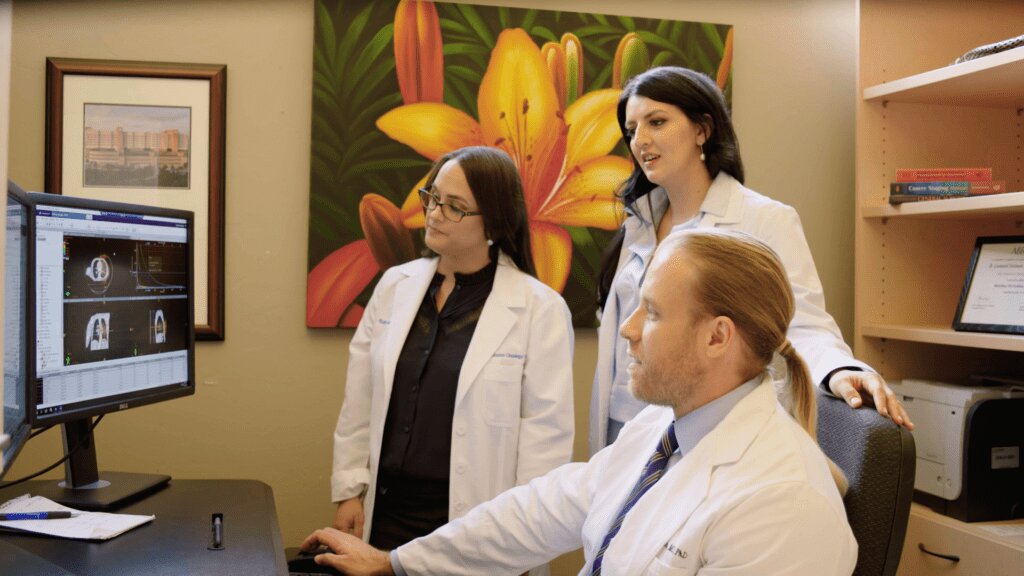Precise and Accurate Treatment
Our physicians and staff are constantly striving to improve the quality of care we provide. We offer image-guided radiation therapy (IGRT) in Tucson as part of this commitment. IGRT involves the use of frequent imaging during a course of radiation therapy to improve the precision and accuracy of the delivery of radiation. This technology allows us to destroy cancer cells while sparing normal tissue more precisely.
What is image-guided radiation therapy (IGRT)?
Image-guided radiation therapy, or IGRT, is a type of radiation therapy that uses imaging during treatment to precisely target the tumor. IGRT can be used for tumors anywhere in the body. For example, neck cancer patients treated with IGRT may have CT, MRI, or PET scans during treatment to help the radiation therapist align the machine with the tumor. IGRT is used in conjunction with conventional radiation therapy, such as the True Beam linear accelerator that is equipped with high-definition imaging capabilities.
IGRT is a radiation delivery technique that allows the radiation oncologist to see a tumor during treatment. This type of radiation therapy uses special cameras and software to track the tumor’s location before and during each treatment. The information from the images is used to ensure the radiation beam is precisely targeted to the tumor.
Image-guided radiation therapy is an important tool in the fight against cancer. This type of radiation therapy allows our physicians to see the head and neck tumors during treatment and make adjustments accordingly. In addition, the IGRT technique may further decrease radiation dose to normal tissues.
Benefits of Image-Guided RadiationTherapy
The use of image-guided radiation therapy (IGRT) has many potential benefits for cancer patients. This type of radiation therapy can provide:
Enhanced Visualization
IGRT can provide a more precise and more detailed view of the tumor, allowing our doctors to target the cancerous cells better while sparing surrounding healthy tissue.
Reduced Side Effects
By targeting only the tumor with radiation, IGRT can help reduce the risk of side effects.
Precise Delivery
IGRT can help ensure that the radiation dose is delivered precisely to the tumor site.
Improved Quality of Care
IGRT can help improve cancer patients’ overall quality of care.
Surface Guided Radiation Therapy (SGRT)
Surface Guided Radiation Therapy (SGRT) is a system used to track the patient’s skin surface / body contour in real time to ensure the patient doesn’t move during radiation delivery. This makes treatment safer and more comfortable for patients.
AlignRT is the system we utilize; it is equipped with infrared cameras that monitor the patient’s skin surface and pause the machine automatically if the patient moves out of the correct position. This gives us sub-millimeter precision and allows us to avoid the use of traditional closed face masks.
Cancer Treatment Just Got More Precise
Image-guided radiation therapy (IGRT) is a cutting-edge cancer treatment that offers many potential benefits for patients. IGRT can help improve the precision and accuracy of radiation delivery, which can lead to better outcomes and fewer side effects.

IGRT radiation therapy adds an extra layer of precision to this already effective treatment by allowing our physicians to see the tumor’s location immediately before each radiation therapy session. This way, we can ensure that the tumor is in the treatment field and that the surrounding healthy tissue is not being exposed to unnecessary radiation.
Radiation Therapy Treatment Process
The following are typical steps in an image-guided radiotherapy procedure:
Simulation
The first step in radiation treatments is called simulation. This is used to map the area to be treated. The simulation is much like getting a CT scan, but it takes longer. You will lie on a table, and the radiation therapist will take pictures of the area to be treated. Tumor imaging studies may be performed during simulation. During this time, marks may be placed on your skin. These marks are used to line you up correctly for treatment.
Technical Planning
Once the simulation is complete, a radiation oncologist will determine the type and dose of radiation treatment you will need. This is based on the cancer type, size, and location. The radiation oncologist will also review the CT images from the simulation.
Treatment
Treatment is similar to simulation, except you will receive the actual radiation therapy. The machine will move around you and direct the radiation to the treated area. Each treatment lasts only a few minutes. A full round of treatment usually takes place over the course of several weeks.
Follow-Up
After treatment is complete, you will have follow-up visits with your radiation oncologist and other care team members. These appointments are important to track your progress and side effects.

Our Physicians’ Goal
Our goal is to provide the highest-quality care to our patients at our cancer center. We want to ensure that they receive the most effective treatment possible while minimizing radiation exposure. IGRT is one way we are able to achieve this goal.
We will help our patients understand all of their treatment options and work with them to create a treatment plan tailored to their individual needs. If you have been diagnosed with cancer, we encourage you to contact us to learn more about how we can help you.
Radiation Oncology Program
Our radiation oncologist works with a team of highly skilled professionals to provide comprehensive care for our patients. The team includes medical oncologists and surgeons, neuro-oncologists, and neurosurgeons. We offer a full range of radiation therapy services, including:
- Image-guided radiation therapy (IGRT)
- Stereotactic Radiosurgery (SRS)
- Intensity Modulated Radiotherapy / Intensity Modulated Radiation Therapy (IMRT)
- RapidArc® Radiation Therapy
We offer the most advanced and comprehensive radiation therapy care available. We are dedicated to providing our patients with the best possible outcomes and quality of life.
Why choose us for IGRT?
Highlights of our program include:
- Innovative techniques: Our radiation oncologists are constantly investigating new ways to improve the accuracy of IGRT and minimize side effects.
- Personalized care: We take a team approach to your care, involving radiation oncologists, neurosurgeons, medical oncologists, and other specialists as needed. This ensures that you receive comprehensive, individualized care.
- Focused training: Each of our radiation therapists has specialized training in IGRT and participates in ongoing education to keep up with the latest advances.
- Commitment to excellence: We are committed to providing the highest quality of care. We pursue new tools and treatments that can improve outcomes for our patients. Participating in wide-ranging clinical trials allows us to offer our patients the most advanced treatments available.
